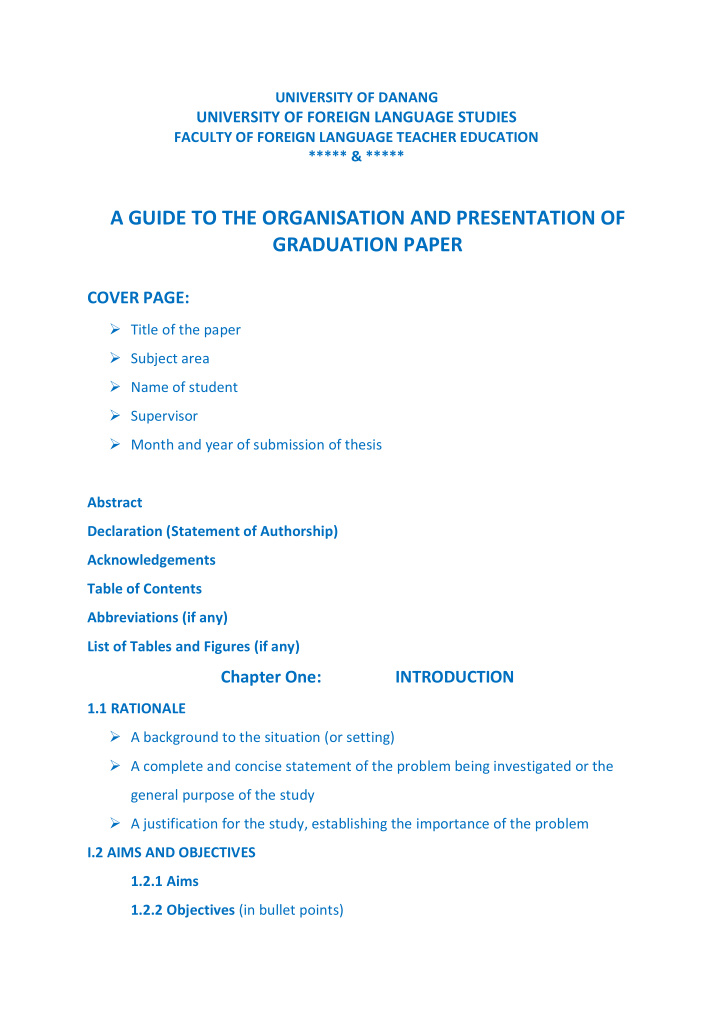



UNIVERSITY OF DANANG UNIVERSITY OF FOREIGN LANGUAGE STUDIES FACULTY OF FOREIGN LANGUAGE TEACHER EDUCATION ***** & ***** A GUIDE TO THE ORGANISATION AND PRESENTATION OF GRADUATION PAPER COVER PAGE: ➢ Title of the paper ➢ Subject area ➢ Name of student ➢ Supervisor ➢ Month and year of submission of thesis Abstract Declaration (Statement of Authorship) Acknowledgements Table of Contents Abbreviations (if any) List of Tables and Figures (if any) Chapter One: INTRODUCTION 1.1 RATIONALE ➢ A background to the situation (or setting) ➢ A complete and concise statement of the problem being investigated or the general purpose of the study ➢ A justification for the study, establishing the importance of the problem I.2 AIMS AND OBJECTIVES 1.2.1 Aims 1.2.2 Objectives (in bullet points)
1.3 Research Questions 1.4 Scope of the Study ➢ A statement of the scope of the study 1.5 Organisation of the Study ➢ A preview of the organization of the rest of the paper to assist readers in grasping the relationship between various components Hypothese s (if any) Definition of Terms (if any) Chapter Two: LITERATURE REVIEW AND THEORETICAL BACKGROUND 2.1 Review of Literature ➢ A review of previous studies related to the problem under investigation - Comments and a statement of unsolved problems 2.2 Theoretical Background ➢ Some theoretical knowledge Chapter Three: RESEARCH METHODOLOGY 3.1 Research Design ➢ Qualitative (preferable)/ Quantitative or both 3.1 Research Methods ➢ Description of Population and Sample (if any) 3.1 Data Collection and Data Analysis ➢ Data Collection ➢ Instruments for analysis (if any) ➢ Data Analysis 3.4 Discussion of Reliability and Validity
Chapter Four: DISCUSSION OF FINDINGS/RESULTS ➢ Interpretation and discussion of results/findings of the research Chapter Five: CONCLUSION 5.1 A summary of the development of the study 5.2. A brief re-statement of the findings 5.3. IMPLICATIONS: Practical solutions drawn from the research 5.4. LIMITATIONS 5.5. SUGGESTIONS FOR FURTHER RESEARCH: A statement of unanswered questions that require further research beyond the limits of the study REFERENCES ➢ Reference system: The APA system ➢ List only works cited or referred to in the study ➢ Alphabetical order
Appendixes 1. NUMBER OF COPIES TO BE SUBMITTED: 3 copies, soft cover. Hard copies will be submitted after the defense and amendments made. 2. FORMAT 2.1. Length: 50-70 pages, A4 (29.7cm X 21cm), typed or computer generated 2.2. Font type: Times New Roman Unicode 2.3. Font size: 13 2.4. Line space: 1.5 2.5. Margins: Right: 2cm Left: 3.5cm Top: 3.5cm Bottom: 3cm 2.6. Page number: Top, Centered 2.7. Lower case Roman numerals: (I, ii, iii, iv,….) 2.8. Arabic numerals: (1, 2, 3,…) for main part 2.9. Chapter number: Chapter 1, Chapter 2, Chapter 3,…, centered 2.10. Heading level 1: 1, 2, 3,… 2.11. Heading level 2: 1.1, 1.2, 1.3,… 2.12. Heading level 3: 1.1.1, 1.1.2 2.13. Heading level 4: 1.1.1.1 a. b. c. 2.14. In-text referencing: Direct quotation (Name, Year of publication, Page number) Indirect quotation (Name, Year)
3. APA Format Citation Guide This is a complete guide to APA (American Psychological Association) in-text and reference list citations. This easy-to-use, comprehensive guide makes citing any source easy. Check out our other citation guides on MLA 8 and Harvard referencing. Core Components of an APA Reference: 1. APA Referencing Basics: Reference List A reference list is a complete list of references used in a piece of writing including the author name, date of publication, title and more. An APA reference list must: • Be on a new page at the end of the document • Be centred • Be alphabetically by name of first author (or title if the author isn’t known, in this case a, an and the should be ignored) o If there are multiple works by the same author these are ordered by date, if the works are in the same year they are ordered alphabetically by the title and are allocated a letter (a,b,c etc.) after the date • Contain full references for all in-text references used
APA Referencing Basics: In-Text Citation In-text references must be included following the use of a quote or paraphrase taken from another piece of work. In-text citations are citations within the main body of the text and refer to a direct quote or paraphrase. They correspond to a reference in the main reference list. These citations include the surname of the author and date of publication only. Using an example author James Mitchell, this takes the form: Mitchell (2017) states… Or … (Mitchell, 2017). The structure of this changes depending on whether a direct quote or parenthetical used: • Direct Quote: The citation must follow the quote directly and contain a page number after the date, for example (Mitchell, 2017, p.104). This rule holds for all of the variations listed. • Parenthetical: The page number is not needed. TWO AUTHORS: The surname of both authors is stated with either ‘and’ or an ampersand between. For example: Mitchell and Smith (2017) state … Or … (Mitchell & Smith, 2017). THREE, FOUR OR FIVE AUTHORS: For the first cite, all names should be listed: Mitchell, Smith, and Thomson (2017) state … Or … (Mitchell, Smith, & Thomson, 2017). Further cites can be shorted to the first author’s name followed by et al: Mitchell et al (2017) state … Or … (Mitchell et al, 2017).
Recommend
More recommend